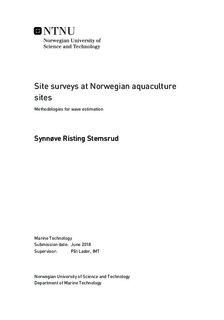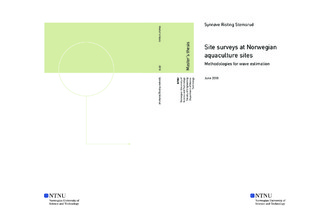| dc.description.abstract | New concepts of ocean-based fish farming are emerging in the aquaculture industry, which aim to increase production efficiency and expand usable farming space. These recent developments raise a need for evaluating present methodologies and requirements of site surveys. Legislation and regulations governing Norwegian aquaculture production are presented, with the main aim of identifying potential areas for policy improvement. In particular, the consequences of technical advances on legislative development in aquaculture are discussed. Relevant recommended practices and technical standards from other ocean engineering industries, as well as current methodologies for met-ocean estimation and design principles for marine structures are addressed.
Site surveys, including measurements of wind, waves and current, provide a basis for the estimated design levels of the environmental loads. Reported wave conditions are analyzed and the causes of deviation between estimation methods and their resulting wave conditions are investigated. The main findings are as follows:
- Fetch analysis is the most applied wind-wave estimation method (32\%), followed by the numerical wave model SWAN (18\%)
- There are large geographical variations in the wind-wave estimation methods applied
- SWAN analysis results in larger calculated wave heights compared to fetch length analysis
- Numerical wave models are mainly used at sites operated by large sized fish farming companies, whereas fetch length analysis is mainly used by small/ medium sized companies
The findings suggest a possible dependency of the wave estimation methodologies applied in site surveys on the fiscal strength and production capacity of fish farming companies. This observation, if further substantiated, may imply an infringement of the legal requirement for independent inspection bodies, as stipulated in NYTEK \S7. The findings thus contribute to a platform for further evaluation of the legal framework governing future aquaculture installations. | |

